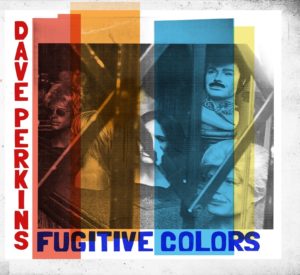“Inspired guitar, inspired lyrics, distinctive voice—sounds like no one else.”
Raw but elegant guitar architecture…lyrics that conjure spirits of the past…a voice sculpted by time and experience…these are the defining characteristics of Dave Perkins’ Fugitive Colors, an eclectic collection of songs that bridge the boundary lines of multiple genres of American music. One early listener described Fugitive Colors as “genre-free.” Thanks to Perkins’ individualistic guitar approach to song construction, the question is blurred as to where, if in any of the usual locations, this album belongs. Americana? Contemporary folk rock? Alternative rock? Singer-songwriter?
When asked about the album’s title, Perkins responded, “Fugitive colors are deferred emotions, delayed reactions, deep feelings that have risen from hidden places.” Forgotten feelings are sometimes triggered by a chance encounter that stirs the memory, or, they may be resurrected by challenging circumstances. In recent years, Perkins has had his own challenges, of which we hear echoes in songs like “Blue Into Black,” “Away,” and “Stand.”
In one of Fugitive Colors recurring themes, joy and lament dance together revealing how love and friendship are resilient against the erosion of time. Facts may blur, but the feelings remain true. The stories get richer with time and telling.
“A Lot of Good Men Gone Down”—written for Perkins’ father and several music-making friends who died too young—asks, “Is there a wind that blows making old friends call, just when they’re on your mind. And who’s been pushing that button up there that makes your time rewind.” This question sets the tone for several of the album’s songs. Together they put weight on the idea that the stories of our lives, deep feelings for long-lost love and friendships are always with us and shape our perceptions of who we are. The beautiful sadness of “The Wind in the Attic”, the humor in the story of the gambling girlfriend of “New Jimmy’s” all reflect the richness that relationships, good or bad, bring to our lives.
Lyrics that read in one instance like Flannery O’Connor and, in another, like Beat Poetry delivered by a voice that has clearly seen life in its extremes, propped up by masterful (even if deconstructed) guitars—this is Fugitive Colors. For one listener, Fugitive Colors is the best yet assemblage of Dave Perkins’ distinctive gifts: “Inspired guitar, inspired lyrics, distinctive voice—sounds like no one else.”
Dave Perkins’ musical journey has taken varied and equally eclectic paths. His work as a guitarist, on the road and in the studio, includes fiddle master Vassar Clements, blues and jazz violinist Papa John Creach, singer-songwriter Carole King, Texas renegade Jerry Jeff Walker, Americana godfather Guy Clark, reggae band Mystic Meditations, alt-rockers Chagall Guevara, hard-core techno-punk Passafist, and, for a brief but instructive stint, Ray Charles. Perkins’ last solo project “Pistol City Holiness”, homage to his love of the blues, received much praise in the press and online. His studio work and songwriting have appeared on a multitude of music projects including albums, film and TV.
